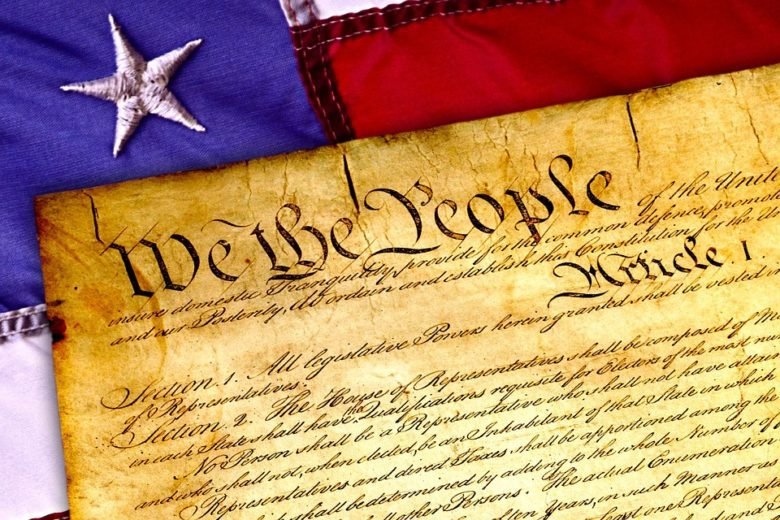Stay Alert! U.S. Vice President To Lead Federal “Office of Gun Violence Prevention”
Talk about the ideals of a limited government.
That is the strange idea that the purpose of government is to protect a citizen’s Natural rights.
Indeed, this strange idea of a representative democracy, that confers limited powers upon the federal government, is enshrined in the U.S. Constitution and reinforced in its Tenth Amendment:
“The powers not delegated to the United States by the Constitution, nor prohibited by it to the States, are reserved to the States respectively, or to the people.”
Say what?
While many conservatives are trying to conserve the traditions of American founding institutions and values, progressive leftists struggle to resist breaking away from the Constitution.
Ever since former U.S. president Woodrow Wilson argued that “government is not a machine, but a living thing” in the early 20th century, the idea of “living political constitutions” has been used to justify government expansion, powered by the underlying belief that the power of the state trumps the rights of the individual.
Republican politicians, who tend to attract social and fiscally conservative voters, often prefer most of the responsibility for government programs to rest at state and local levels—but they haven’t been precisely free of charge in opposing federal government expansion.
Democrat politicians, who cater to progressive leftists, likely believe the federal government should have a strong role in directly addressing the challenges faced by the American people. It may be fair to say that a significant proportion of Democrats believe that industries such as banking, insurance, health care and manufacturing should have considerable federal oversight and involvement.
And that oversight includes entrenching bureaucratic bolts into the Second Amendment of the Constitution of the United States:
“A well regulated Militia, being necessary to the security of a free State, the right of the people to keep and bear Arms, shall not be infringed.”
Period.
But, the Democratic Party cannot seem to contain a desire for greater centralized power in the federal government. In late September, U.S. President Joe Biden and Vice President Kamala Harris announced a new office—the “Office of Gun Violence Prevention.”
If you haven’t already, then brace yourself: no defender of the Constitution should take their eye off what is becoming an increasingly bulging belly of an administrative state.
Firstly, rewind to March. Three Democrats, Representative Maxwell Alejandro Frost of Florida and Senators Chris Murphy and Richard Blumenthal of Connecticut, introduced bicameral legislation to establish the new office in the U.S. Department of Justice (DOJ.)
An attempt to justify the Office of Gun Violence Prevention Act was expressed in a press release statement:
-
Growing up in a generation “defined by mass shootings,” said Frost;
-
and so to “save as many lives as humanly possible,” added Murphy;
-
by mobilizing “professionals across federal agencies, enable outreach to state and local leaders, collect and report more data,” said Blumenthal.
Under a year later, the vice president announced at a press conference that “the full power of the federal government” is going to be used, since Harris will lead and oversee the new office. Meanwhile, Biden’s 2020 policy director and staff secretary, Stefanie Feldman, will serve as its director.
“We agree that in a civil society, the people must be able to shop in a grocery store, walk down the street, or sit peacefully in a classroom and be safe from gun violence,” Harris said. “But instead, our nation is being torn apart by the tragedy of it all and torn apart by the fear and trauma that results from gun violence.”
When it was Biden’s turn to speak, he praised the Republican senators who voted for so-called “common sense gun laws” in 2022, and helped to pass the Bipartisan Safer Communities Act. A reminder that those of us likely to vote Republican need to hold our elected officials accountable and, if necessary, vote them back in—or out of Congress.
Indeed, this latest move to address—and ideally prevent—violence and the loss of lives caused by guns in the hands of criminal-minded thugs isn’t the first of the Biden administration.
As detailed in a previous article, the White House disclosed a federal regulation in April 2022 targeting “ghost guns.” Such firearms are sold without background checks, assembled from kits and do not contain serial numbers like traditional firearms, making them easy to obtain and untraceable to federal law enforcement. Yet this new rule has reportedly done little to curb the manufacturing and spread of such guns—just adding more to the belly bulge of an administrative state.
As the Democratic Party set sights on the 2024 U.S. presidential election, Biden expressed hopes that the Office of Gun Violence Prevention will function similarly to how the Federal Emergency Management Agency (FEMA) responds to natural disasters.
Yes, he really said that.
If we dispassionately examine gun violence in absolute numbers, there are around 120 daily gun-related incidents in the United States. To date, in 2023 alone, there have been over 30,000 deaths due to gun violence and over 50 percent of those deaths were due to suicide, according to the Gun Violence Archive.
On a global scale, the countries with the highest total gun deaths in 2019 include Brazil, the United States and Venezuela, according to World Population Review. That said, the countries with the highest homicides per 100,000 residents that same year include El Salvador, Venezuela and Guatemala. The United States didn’t even make the top 10—in truth, mass shootings account for a small percentage of violent gun deaths. Instead, over 60 percent of gun deaths in the U.S. in 2019 were suicides.
That said, mass shootings are notably higher in the United States than in other developed countries. Actually, countries with levels of gun-related deaths similar to the U.S. tend to be developing countries embroiled in violent civil unrest or war.
Interestingly enough, the U.S. also has the highest level of income inequality among the Group of 7 (G7) developed nations. A study published in 2019 by BMC Public Health analyzed mass shooting data from the U.S. Federal Bureau of Investigation (FBI), and socioeconomic data from the U.S. Bureau of the Census in 3144 counties between 1990 and 2015. The authors of the study reported that:
“Counties with growing levels of income inequality are more likely to experience mass shootings. We assert that one possibility for this finding is that income inequality fosters an environment of anger and resentment that ultimately leads to violence.”
Consider the prospect of reducing the welfare state over one generation while maximizing work opportunities, to compel more working-age able-bodied Americans to earn an honest living.
Most people may not earnestly desire to be multi-millionaires. However, many inherently want a healthy work-life balance, stable and secure relationships, and a paycheck that provides some disposable income for saving.
Furthermore, there is a valid point to raise about the mental health of perpetrators who engage in mass shootings.
-
The publication Mother Jones analyzed a database of mass shootings from 1982 through 2012, and found that roughly 50 percent of individuals who committed the attack had some form of “mental health issue,” including a diagnosis of a severe mental disorder.
-
A 2017 analysis by Everytown for Gun Safety highlighted that in mass killings between 2009 and 2016, the shooter exhibited warning signs of troubling behavior and posed a danger to themselves in 42 percent of cases.
O-kay.
So does 42 to 50 percent imply that the remaining proportion weren’t suspected of having some form of psychological disturbance or a “mental disorder,” at least in clinical diagnosis?
To further investigate, a 2001 study by the University of California examined the background of 34 adolescent shooters involved in mass killings between 1958 and 1999. The authors found that:
-
70 percent were described as “loners”
-
61.5 percent suffered from substance abuse
-
48 percent held weapon fetishes
-
43.5 percent had been subjected to bullying
-
23 percent had a reported psychiatric history.
More significantly, the research concluded that “depressive symptoms and historical antisocial behaviors were predominant” among the shooters.
Most people who exhibit depressive symptoms do not commit acts of violence against others—but those likely to engage in mass shootings have a “will to live” glitch missing, as they tend to die at the crime scene by suicide or resign themselves to life behind bars.
Still, let’s keep digging for more insight.
A reportedly “landmark” study from the Duke University School in 1990 showed that 7 percent of individuals with schizophrenia, bipolar disorder, or major depression had engaged in “minor or serious violent behavior” towards others within the preceding year of psychiatric assessment.
The study’s primary author, Professor Jeffrey Swanson, expressed the “vast majority of people with serious mental illnesses are not violent.” According to Swanson, public mass shootings would decline by only 4 percent if such disorders were eliminated.
As someone who has worked in education, observing student characteristics and behavior was akin to waking up in the morning and brushing one’s teeth. Regardless of whether a child psychiatrist had diagnosed a student with a form of psychological disturbance, we, as educators, would attempt to find ways to support young people who exhibited warning signs for potential aggressive behavior and violence.
(And to all the people who have not worked in education over the last twenty years—a visible proportion of students exhibit passive-aggressive behavior, and use or misuse prescription drugs to manage some “special educational need” or a slow-brewing inner crisis. Some, will start conjuring ideas involving violence before proudly boasting their action plan to their “internet friends”.)
In recent years, the National Institute of Justice as a research agency of the DOJ has collected, and analyzed a database of U.S. mass shootings from 1966 to 2019.
The database includes background information about every mass shooter who shot and killed four or more people in a public place; and every shooting incident at places of worship, academic institutions and workplaces.
-
To state the obvious, the shooters all had the means to carry out their plans. In cases involving K-12 school shootings, over 80 percent of individuals “stole guns from family members.” Workplace shooters were more likely to use legally owned handguns (77 percent), while other public shooters were more likely to acquire them illegally (13 percent).
-
The researchers also found that most mass shooters experienced early childhood trauma and exposure to violence at a young age; such factors can affect mental health, driving depression, anxiety or suicidal thoughts.
-
Moreover, every mass shooter in the study had reached a “state of crisis” in the days or weeks preceding the shooting, often expressed to others through plans, including specific threats of violence and suicidality.
-
Most shooters had studied other shooters’ actions to model their attacks. In seeking validation from others that their will to murder is justified, many look to unfiltered, uncensored social media platforms over the Internet.
In sharing the statistics above, the intention isn’t to dismiss, downplay, or excuse the seriousness of mass shootings in this young republic. Instead, perhaps the focus should shift from “preventing gun violence” to fostering “good mental health” and “a sense of community” among young people.
Simply put, the right to bear arms to ensure security and protection against tyranny triumphing over We, the People, is imperative—that the lawful people of the United States have the means to collectively match the military capability of a federal army.
Yet, this latest pile by the Democratic Party occupancy in the White House needs to be monitored by protectors of the Second Amendment, almost like hawks, and wiped clean through peaceful, legal means, if shown necessary.
“There are few people who care more about the work of gun violence prevention than President Biden,” said Senator Murphy at the White House press conference in late September. “Establishing a White House office dedicated to this fight will save thousands of lives and strengthen the federal government’s implementation of the Bipartisan Safer Communities Act.”
For all the talk, support for additional gun regulations remains politically divisive. According to a 2022 poll by the University of Chicago Harris School of Public Policy and The Associated Press-NORC Center for Public Affairs Research, although over 70 percent of U.S. adults say gun laws should be stricter—this includes roughly 50 percent of Republicans and over 90 percent of Democrats.
A smaller majority of Americans (59 percent) favor a ban on the sale of AR15 style rifles and similar semiautomatic rifles, with more support from Democrats (83 percent) than Republicans (35 percent.)
The poll also found that 30 percent of Americans support a law allowing people to carry guns in public without a permit. In contrast, 78 percent of Democrats are opposed while 47 percent of Republicans are in favor.
Yet despite the political divide, over half of Americans, including 65 percent of Republicans and nearly 40 percent of Democrats, say reducing mass shootings and protecting the right to own guns for personal protection are highly important.
It is arguably fair to say that most rational, reasonable and balanced folks want to walk or drive through the streets of their local communities with a sense of safety—and a quiet, unspoken confidence in their neighborhood.
Some folks live in neighborhoods where drive-by shootings are the norm, and its youth has no other reference because their local area lacks:
-
economic stability;
-
children living with two parents;
-
high levels of trust between neighbors;
-
sufficient access to medical care;
-
and a sense of belonging to that area.
On a national level, news of mass shootings has, unfortunately, come to be expected for many Americans. But we shouldn’t have to “expect” anything other than promoting a culture of decency, which includes encouraging workforce participation and young people taking up roles that support their church or community health, and wellbeing.
And we aren’t going to give up our God-given rights to bear arms in a country where sane, non-violent, freedom-loving Americans have witnessed a surge in authoritarian and coercive measures over the last three years.
Not now.
Not ever.
Content syndicated from Dear Rest of America with permission
Agree/Disagree with the author(s)? Let them know in the comments below and be heard by 10’s of thousands of CDN readers each day!





Referring to the Constitution Harris said, “Cackle-Cackle-Cackle, Yuk-Yuk, Snort-Cackle-Yuk”.